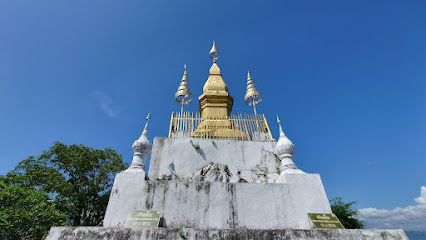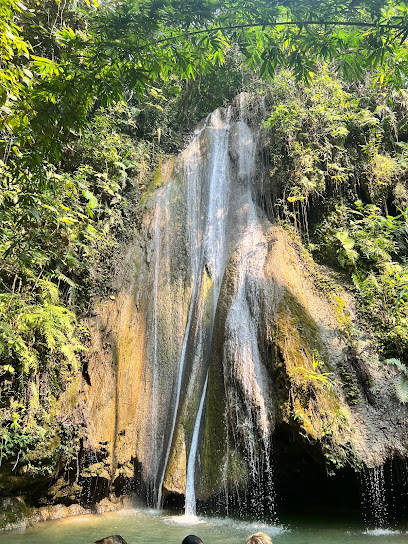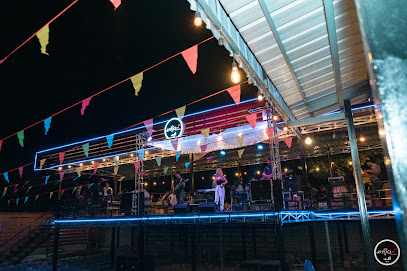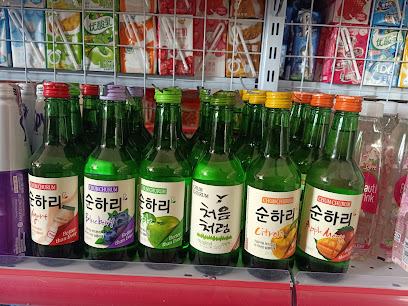
Muang Sing: The Hidden Gem of Northern Laos
Discover Muang Sing, a tranquil town in Northern Laos, known for its vibrant markets, rich cultural heritage, and stunning natural landscapes ideal for eco-tourism and trekking.
Muang Sing is a charming town nestled in the lush mountains of Northern Laos. Known for its rich cultural heritage and scenic landscapes, this small town offers a unique glimpse into the traditional way of life in Laos. Visitors to Muang Sing are often captivated by its serene atmosphere and the warm hospitality of the local people. Explore the vibrant morning market where ethnic minority groups, such as the Akha, Hmong, and Tai Lue, come to trade their goods. The market is a colorful display of traditional clothing, handmade crafts, and fresh produce. It's a great place to interact with the locals and learn about their customs and traditions. The surrounding countryside offers numerous opportunities for trekking and eco-tourism. Hike through verdant rice paddies, dense forests, and remote villages where time seems to stand still. Along the way, you can visit ancient stupa sites and local temples, which provide a fascinating insight into the region's spiritual practices. Don't miss the Nam Ha National Protected Area, a haven for wildlife and a paradise for nature lovers. In Muang Sing, you can also experience traditional Lao cuisine, which is characterized by its bold flavors and fresh ingredients. Savor dishes like laap (minced meat salad), tam mak hoong (green papaya salad), and khao niao (sticky rice). Many local restaurants and guesthouses offer cooking classes, giving you the chance to learn how to prepare these delicious dishes yourself. Whether you are an adventurer, a culture enthusiast, or simply looking for a peaceful retreat, Muang Sing has something to offer. Its blend of natural beauty, cultural richness, and warm community spirit makes it a must-visit destination in Laos.
Local tips in Muang Sing
- Visit the morning market early to experience the bustling atmosphere and see the widest variety of goods.
- Hire a local guide for trekking to gain deeper insights into the culture and history of the area.
- Respect local customs and dress modestly, especially when visiting temples and villages.
- Try the local cuisine and don't miss the chance to take a cooking class.
- Bring cash, as credit card facilities are limited in this remote area.
- Visit the Nam Ha National Protected Area for a chance to see rare wildlife and enjoy pristine nature.
Muang Sing: The Hidden Gem of Northern Laos
Muang Sing is a charming town nestled in the lush mountains of Northern Laos. Known for its rich cultural heritage and scenic landscapes, this small town offers a unique glimpse into the traditional way of life in Laos. Visitors to Muang Sing are often captivated by its serene atmosphere and the warm hospitality of the local people. Explore the vibrant morning market where ethnic minority groups, such as the Akha, Hmong, and Tai Lue, come to trade their goods. The market is a colorful display of traditional clothing, handmade crafts, and fresh produce. It's a great place to interact with the locals and learn about their customs and traditions. The surrounding countryside offers numerous opportunities for trekking and eco-tourism. Hike through verdant rice paddies, dense forests, and remote villages where time seems to stand still. Along the way, you can visit ancient stupa sites and local temples, which provide a fascinating insight into the region's spiritual practices. Don't miss the Nam Ha National Protected Area, a haven for wildlife and a paradise for nature lovers. In Muang Sing, you can also experience traditional Lao cuisine, which is characterized by its bold flavors and fresh ingredients. Savor dishes like laap (minced meat salad), tam mak hoong (green papaya salad), and khao niao (sticky rice). Many local restaurants and guesthouses offer cooking classes, giving you the chance to learn how to prepare these delicious dishes yourself. Whether you are an adventurer, a culture enthusiast, or simply looking for a peaceful retreat, Muang Sing has something to offer. Its blend of natural beauty, cultural richness, and warm community spirit makes it a must-visit destination in Laos.
When is the best time to go to Muang Sing?
Iconic landmarks you can’t miss
Patuxay - Victory Monument
Discover the beauty of Patuxay, Vientiane's iconic Victory Monument blending history, culture, and breathtaking views in one unforgettable experience.

Pha That Luang Vientiane
Discover the grandeur of Pha That Luang, Laos' iconic golden stupa, a symbol of faith and cultural heritage in Vientiane.

Phousi Hill
Discover the serene beauty of Phousi Hill, a sacred site in Luang Prabang offering stunning views and a glimpse into Buddhist culture.

Wat Xiengthong
Discover the stunning beauty and rich heritage of Wat Xiengthong, a must-visit Buddhist temple in the heart of Luang Prabang, Laos.

National Museum
Explore the rich heritage of Laos at the National Museum in Luang Prabang, where history comes alive through fascinating exhibits and royal relics.

Nam Xay Viewpoint
Experience the breathtaking views at Nam Xay Viewpoint, a hidden gem in Laos offering stunning panoramas of lush landscapes and serene surroundings.

Nam Ha National Bio-Diversity Conservation Area
Discover the unparalleled biodiversity and breathtaking landscapes of Nam Ha National Bio-Diversity Conservation Area, a true natural gem in Laos.

Nong Khiaw Viewpoint
Discover the stunning Nong Khiaw Viewpoint, where breathtaking landscapes of Laos await you with panoramic views of mountains and rivers.

Zuela
Experience the tranquility of Luang Namtha at Zuela, your charming guesthouse gateway to Northern Laos adventures.

Na tery Village
Experience the authentic charm of Na Tery Village in Laos, where friendly locals and stunning landscapes await to captivate every tourist.

Thoulasith Guesthouse
Discover the charm of Luang Namtha at Thoulasith Guesthouse, where comfort meets local culture in a picturesque setting.

Lai's Place
Discover the vibrant fusion of Lao and international cuisine at Lai's Place, a must-visit restaurant in Luang Namtha for food lovers.

The Hiker Travel Agency Laos
Explore the majestic landscapes and rich culture of Luang Namtha with expert-guided tours from The Hiker Travel Agency Laos.

Discovering Laos
Unleash your adventurous spirit with Discovering Laos, your premier tour operator for unforgettable experiences in the heart of nature.

Morning market
Explore the vibrant Morning Market in Muang Sing for fresh produce, local delicacies, and an authentic cultural experience in Laos.

Unmissable attractions to see
Nam Ha National Bio-Diversity Conservation Area.
Explore the breathtaking landscapes and rich biodiversity of Nam Ha National Bio-Diversity Conservation Area in Laos, a paradise for nature lovers and adventurers.

Nam Ha National Bio-Diversity Conservation Area
Discover the breathtaking biodiversity and stunning landscapes of Nam Ha National Bio-Diversity Conservation Area, a must-visit national park in Laos.

Water Fall Nam Dee
Experience the breathtaking beauty of Waterfall Nam Dee, a serene oasis in Luang Namtha offering nature trails and refreshing dips in crystal-clear waters.

19 Station
Discover the vibrant nightlife at 19 Station, a lively bar offering a unique blend of local culture, delicious drinks, and a friendly atmosphere.

Tad Mook Waterfalls
Explore the mesmerizing Tad Mook Waterfalls, a hidden gem in Sop Keng, Laos, where nature meets tranquility and beauty.

Kao Rao Cave
Discover the captivating beauty and historical allure of Kao Rao Cave in Laos, a remarkable natural wonder waiting to be explored.

Chom Ong Cave | ຖຳ້ຈອມອອງ
Discover the enchanting beauty of Chom Ong Cave, a stunning underground marvel in Ban Ka Lang Khouang, perfect for nature lovers and adventurers.

Nam Ha Hill Tribe Eco-Trek
Experience the beauty and culture of Laos with an unforgettable trek through the Nam Ha Hill Tribe Eco-Trek, a premier eco-tourism destination.

Candle Tree Forest ປ່າໄມ້ລຳທຽນ
Discover the enchanting Candle Tree Forest in Lan Ting, a serene retreat featuring unique candle-shaped trees and stunning natural beauty.

Essential places to dine
Lai's Place
Experience the exquisite blend of traditional Laotian flavors with modern culinary techniques at Lai's Place in Luang Namtha.

Manychan
Experience culinary creativity at Manychan, where traditional Lao flavors meet international cuisine in the heart of Luang Namtha.

Fan Mai
Discover the heart of Lao cuisine at Fan Mai in Luang Namtha – where every meal tells a story.

ຮ້ານຊີ້ນດາດໃບເຕີຍ Baiteuy Restaurant
Experience authentic Laotian flavors in a warm atmosphere at Baiteuy Restaurant in Muang Sing.

ແຮັບປີ
Experience authentic Laotian cuisine at ແຮ╔ນາເນານໃໝ່ ສານໃໝ່ with delicious traditional dishes and warm hospitality.

Sainamtha
Experience the authentic taste of Laos at Sainamtha - a culinary delight in Luang Namtha offering diverse dishes at affordable prices.

ຮ້ານຊີ້ນດາດໂຊກໄຊ
Savor authentic Lao cuisine at ຮ້ານຊີ້ນດາດໂຊກໄຊ in Muang Sing – where tradition meets taste in every dish.

Nat Phob
Experience authentic Lao cuisine at Nat Phob in Luang Namtha – where local flavors meet delightful dining.

หงคำ
Experience authentic Lao cuisine at หงคำ in Muang Sing—where every meal tells a story of tradition and flavor.

ມູມສະບາຍ Moomsabai
Discover the rich flavors of Lao barbecue at Moomsabai, where every bite tells a story of tradition and culinary excellence.

ຮ້ານເຂົ້າຊອຍ ນາງ ຕິກ Khao soy Restaurant
Savor the authentic tastes of Laos at Khao Soy Restaurant in Luang Namtha – a culinary delight not to be missed!

Noodle Shop
Experience authentic Lao cuisine at the Noodle Shop in Luang Namtha—delicious noodles crafted with local ingredients await you!

Rice Field Restaurant
Discover authentic Laotian cuisine amidst stunning rice field views at Rice Field Restaurant in Luang Namtha.

Akha Restaurant
Experience authentic Akha cuisine at Akha Restaurant in Muang Sing - where tradition meets flavor in every dish.

Singsavan
Discover authentic Laotian cuisine at Singsavan - a cozy restaurant in Luang Namtha offering delicious local dishes and warm hospitality.

Markets, malls and hidden boutiques
Morning market
Discover the colorful and bustling atmosphere of Muang Sing's Morning Market, a hub of fresh produce and local culture in Laos.

ຕະຫຼາດ ເມືອງສິງ
Explore the Muang Sing Market, a bustling hub of local culture, crafts, and cuisine in the heart of Laos, perfect for unique souvenirs and authentic experiences.

Muang Sing Night Market
Discover the vibrant Muang Sing Night Market, a cultural hub where delectable local cuisine, unique crafts, and lively entertainment come together.

ຮ້ານ ຂາຍອາຫານສັດ
Experience authentic Laotian cuisine in Muang Sing at ຮ້ານ ຂາຍອາຫານສັດ, where every dish tells a story of local flavors.

בית קפה
Discover Café Serenity in Muang Sing for a cozy coffee experience, combining local flavor and a tranquil atmosphere for every traveler.

hongda6 Aming mobile
Explore the latest in electronics at Hongda6 Aming Mobile in Muang Sing, where technology meets local culture and exceptional service.

Noodle Soup Shop
Discover authentic Asian flavors at Muang Sing's Noodle Soup Shop - a culinary gem for noodle lovers and food enthusiasts.

A THAO
Discover the charm of local craftsmanship at A Thao, a store in Muang Sing offering unique handmade crafts and traditional textiles.

ຮ້ານນາງແສງຍອດຂາຍເຄື່ອງກໍ່ສ້າງຄົບວົງຈອນ
Explore Muang Sing's leading building materials store, offering quality supplies and expert advice for all your construction needs.

ຮ້ານຂາຍຢານາງອຳພອນ Pharmacy shop
Explore the essentials of health and wellness at ຮ້ານຂາຍຢານາງອຳພອນ Pharmacy in Muang Sing, Laos – your go-to pharmacy for all health needs.

ຮ້ານນາງອອ່ນແກ້ວ ຂາຍເຄື່ອງກໍ່ສ້າງ
Explore the vibrant building materials store in Muang Sing, a hub of local craftsmanship and community spirit reflecting Laos' unique culture.

KP mobile Computer
Discover the best in electronics at KP Mobile Computer, your go-to store in Muang Sing for all tech needs.

ມະຫາຊັບ ການຄ້າ Mahasap Trading
Explore Muang Sing with ease at Mahasap Trading, your local convenience store offering snacks, beverages, and essential travel items.

ໂຮງຂ້າສັດ ຈູເລົາເທີ
Explore the authentic flavors of Laos at ໂຮງຂ້າສັດ ຈູເລົາເທີ, your gateway to local meats and culinary traditions.

หลวงน้ำทา
Explore authentic Laotian products and flavors at หลวงน้ำทา, a charming grocery store in Muang Sing, Laos, perfect for culinary enthusiasts.

Essential bars & hidden hideouts
ຮ້ານຊີ້ນດາດໃບເຕີຍ Baiteuy Restaurant
Discover the authentic flavors of Laos at Baiteuy Restaurant, where traditional cuisine meets a warm, inviting atmosphere in Muang Sing.

ແຮັບປີ
Savor authentic Laotian cuisine at ແຮັບປີ, a culinary treasure in Muang Sing that embodies the flavors and culture of Laos.

19 Station
Discover the lively atmosphere of 19 Station, where great drinks and unforgettable experiences await in the heart of the city.

หงคำ
Experience the authentic flavors of Laos at หงคำ, a must-visit restaurant in Muang Sing that delights with local culinary traditions.

ຮ້ານມາຊິວ
Discover the lively ambiance and authentic flavors at ຮ້ານມາຊິວ, a must-visit bar in Muang Sing for an unforgettable night out.

Akha Restaurant
Experience authentic Lao flavors in the heart of Muang Sing at Akha Restaurant, where local ingredients meet traditional recipes.

ຮ້ານບັນເທີງ ໂທນິກ
Experience the vibrant atmosphere and local flavors at ຮ້ານບັນເທີງ ໂທນິກ in Muang Sing, Laos.

ສວນອາຫານສະບາຍໃຈ
Experience the authentic tastes of Laos at ສວນອາຫານສະບາຍໃຈ, a cozy restaurant in Muang Sing serving traditional dishes prepared with love.

sky pub
Experience the vibrant atmosphere of Sky Pub in Luang Namtha, where local culture meets an inviting nightlife scene.

23 Olala Saloon
Discover the lively atmosphere of 23 Olala Saloon, a cocktail bar in Luang Namtha offering creative drinks and local culture.

Check-In-FanMai
Discover the vibrant nightlife at Check-In-FanMai, Luang Namtha's favorite bar for locals and tourists alike, offering a unique blend of culture and fun.

カオソーイ食堂
Savor the authentic taste of Laos at カオソーイ食堂, specializing in the rich and aromatic Khao Soi dish in the heart of Muang Sing.

Soju luangnamtha
Experience the vibrant nightlife of Luang Namtha at Soju Luangnamtha, where local culture meets lively ambiance.

ແມ່ຮ້າງລາວປານ(ຫໍ້)
Explore the vibrant atmosphere of ແມ່ຮ້າງລາວປານ(ຫໍ້) in Muang Sing, where local drinks and culture come alive in a welcoming bar setting.

ແມ່ຮ້າງລາວປານ ຫໍ້
Discover the vibrant nightlife at ແມ່ຮ້າງລາວປານ ຫໍ້ in Muang Sing, where local flavors and a lively atmosphere await you.

Local Phrases
-
- Helloສະບາຍດີ
[sa-baai-dii] - Goodbyeດີດີ
[dee-dee] - Yesດີ
[dee] - Noບໍ່
[bo] - Please/You're welcomeກະລຸນາ
[ka-loun-na] - Thank youຂອບເຂດ
[kop-jai] - Excuse me/Sorryຂ້າພິ
[ka-phi] - How are you?ໂດດູກ່ອນທັນ?
[do-du-kon-than] - Fine. And you?ດິ່ນບໍ່. ແລະ ທັນ?
[dai-bo. lae-than] - Do you speak English?ເຈົ້າพูดພາສາອັງກິດບໍ?
[jao-poot-pa-sa-ang-kit-bo] - I don't understandຂ້າພິ
[ko-khao-jai]
- Helloສະບາຍດີ
-
- I'd like to see the menu, pleaseຂ້າພິເຈົ້າຕ້ອງໃຫ້ຕິດມັນການອາຫານ, ແລະກະລຸນາ
[ka-phi-jao-tong-hai-toi-man-ka-ni-kan-a-han, lae-ka-loun-na] - I don't eat meatຂ້າພິຂ້າພາສາປົກ
[ka-phi-ka-phasa-pok] - Cheers!ຂິຣ
[cheers] - I would like to pay, pleaseຂ້າພິຕ້ອງຈ່າຄິບ, ແລະກະລຸນາ
[ka-phi-tong-jai-ka-pit, lae-ka-loun-na]
- I'd like to see the menu, pleaseຂ້າພິເຈົ້າຕ້ອງໃຫ້ຕິດມັນການອາຫານ, ແລະກະລຸນາ
-
- Help!ຊ່ວຍຊ້າ
[sue-sa] - Go away!ສົມຖະມາ
[som-tha-ma] - Call the Police!ໂທລະພາບ
[tho-la-pa] - Call a doctor!ໂທລະພາບທ່ານ
[tho-la-pa-ta-na] - I'm lostຂ້າພິອອກ
[ka-phi-ok] - I'm illຂ້າພິໂຮງ
[ka-phi-hong]
- Help!ຊ່ວຍຊ້າ
-
- I'd like to buy...ຂ້າພິເຈົ້າຕ້ອງຊື້...
[ka-phi-jao-tong-sue...] - I'm just lookingຂ້າພິຂ້າພາສາປົກ
[ka-phi-ka-phasa-pok] - How much is it?ມື້ນີ້ເງິນເດືອນເຊັດ?
[me-ni-kong-deun-sat] - That's too expensiveທີ່ນີ້ໂຫຼດເງິນບໍ່ຖືກ
[ti-ni-ho-lot-kong-bo-tuk] - Can you lower the price?ເຈົ້າສາມາດເງິນນຳເໝາກົດເຄືອບໄດ
[jao-sa-mat-kong-na-dma-mak-dot-kheub-dai]
- I'd like to buy...ຂ້າພິເຈົ້າຕ້ອງຊື້...
-
- What time is it?ເວລາແມ່ນເມື່ອ?
[wa-la-ma-nme] - It's one o'clockເວລາສາທາວ
[wa-la-sa-tha-wa] - Half past (10)ສາທາວຄິດ
[sa-tha-wa-kit] - Morningເວລາຕອນ
[wa-la-ton] - Afternoonເວລາຫຼັນ
[wa-la-lan] - Eveningເວລາຄິດ
[wa-la-kit] - Yesterdayມື້ວານ
[me-wan] - Todayມື້ນີ້
[me-ni] - Tomorrowມື້ອື້ນ
[me-uen] - 1ໜວດ
[nuat] - 2ສອງ
[song] - 3ສາມ
[sam] - 4ສີ
[si] - 5ຫ້າ
[ha] - 6ໂມງ
[mong] - 7ໂທງ
[thong] - 8ແປງ
[paeng] - 9ເກົ້າ
[kao] - 10ສິບ
[sip]
- What time is it?ເວລາແມ່ນເມື່ອ?
-
- Where's a/the...?ມີໃກ້ບໍ?
[mi-kai-bo] - What's the address?ທີ່ຢູ່ຢູ່ເບີໂທ?
[ti-yue-yue-bo-ho-tho] - Can you show me (on the map)?ເຈົ້າສະເໝີໃນແຜນ?
[jao-sa-mao-nai-phan] - When's the next (bus)?ເວລານັ້ນສິດຕໍ່?
[wa-lan-nan-sip-to] - A ticket (to ....)ໜ້າຟິກັດ (ເຂົ້າ ....)
[na-fik-dat (khao ....)]
- Where's a/the...?ມີໃກ້ບໍ?
History of Muang Sing
-
Muang Sing, located in the northern part of Laos, has a rich tapestry of history dating back centuries. Originally part of the ancient Tai Kingdoms, it played a significant role in regional trade and cultural exchanges. The town's strategic location near the borders of China, Myanmar, and Thailand made it a bustling hub for merchants and traders.
-
In the 14th century, Muang Sing became part of the Lan Xang Kingdom, one of the most powerful kingdoms in Southeast Asia. Under the reign of King Fa Ngum, the kingdom expanded its territories, and Muang Sing flourished as an important administrative and military center. The town's stupa and temples from this period reflect the influence of Theravada Buddhism and the architectural styles of the Lan Xang era.
-
In the late 19th century, Muang Sing came under French control as part of the French Protectorate of Laos. The French established a colonial outpost in the town and used it as a base for their operations in the region. This period saw the construction of colonial buildings and the introduction of Western architectural styles, some of which still stand today.
-
During World War II, Muang Sing was occupied by Japanese forces as part of their campaign in Southeast Asia. The town's strategic location made it a valuable asset for the Japanese military. The occupation brought significant changes to the local economy and infrastructure, including the construction of roads and military outposts.
-
After Laos gained independence from France in 1954, Muang Sing became a part of the newly established Lao People's Democratic Republic. The town saw gradual development and modernization efforts, including improvements in infrastructure and education. Today, Muang Sing is known for its vibrant cultural heritage, traditional festivals, and as a gateway to the Nam Ha National Protected Area.
-
Muang Sing is home to a diverse population, including various ethnic groups such as the Tai Lue, Akha, Hmong, and Yao. Each group has its own unique customs, traditional dress, and festivals. The town's cultural heritage is celebrated through vibrant markets, traditional crafts, and community events that showcase the rich tapestry of ethnic diversity.
-
Historically, Muang Sing was part of the infamous 'Golden Triangle' region, known for its opium production and trade. The town's economy was heavily influenced by the opium trade, which peaked in the mid-20th century. Efforts by the Lao government and international organizations have since focused on eradicating opium cultivation, promoting alternative livelihoods, and developing sustainable tourism.
-
Today, Muang Sing is a thriving town that balances its rich historical heritage with modern development. It has become a popular destination for travelers seeking to explore its cultural landmarks, traditional villages, and natural beauty. The town's markets, temples, and festivals offer visitors a glimpse into the enduring traditions and vibrant life of this historic region.
Muang Sing Essentials
-
Muang Sing is located in the Luang Namtha Province of northern Laos, near the border with China. The nearest international airport is Luang Namtha Airport, which is about 60 kilometers away. From Luang Namtha, you can take a bus or hire a private taxi to reach Muang Sing. The journey typically takes around 1.5 to 2 hours. Alternatively, for a more scenic route, you can travel by boat along the Mekong River and connect to overland transport.
-
Within Muang Sing, transportation options are limited but manageable. Bicycles and motorbikes are popular modes of transport and can be rented from local shops. For short distances, walking is a pleasant way to explore the town. Tuk-tuks and songthaews (shared taxis) are also available for hire. If you are planning to visit nearby villages or natural attractions, renting a motorbike or hiring a local guide with transportation is advisable.
-
The official currency in Laos is the Lao Kip (LAK). While some hotels and larger businesses in Muang Sing may accept US dollars or Thai baht, it is advisable to carry local currency for day-to-day transactions. Credit cards are rarely accepted, so ensure you have enough cash. ATMs are scarce in Muang Sing, so it is recommended to withdraw sufficient funds in Luang Namtha or bring cash with you.
-
Muang Sing is generally a safe destination for tourists. However, as with any travel destination, it is wise to take standard precautions. Avoid walking alone at night in unfamiliar areas and keep an eye on your belongings in crowded places. While Muang Sing does not have specific high-crime areas targeting tourists, it is best to stay vigilant and aware of your surroundings. Petty theft can occur, so secure your valuables.
-
In case of emergency, dial 1191 for police assistance or 1195 for medical emergencies. The local health center in Muang Sing can handle minor health issues, but for more serious medical concerns, you may need to travel to Luang Namtha Provincial Hospital. It is highly recommended to have travel insurance that covers medical emergencies. Pharmacies are available in the town for over-the-counter medications.
-
Fashion: Do dress modestly, especially when visiting religious sites. Avoid wearing revealing clothing. Religion: Do respect local customs and traditions. Always remove your shoes and hat before entering temples and religious buildings. Public Transport: Do be respectful and considerate of others. Don't raise your voice or create disturbances. Greetings: Do greet people with a smile and a slight bow. A traditional 'nop' (hands pressed together in a prayer-like gesture) is also appreciated. Eating & Drinking: Do try local dishes and accept food offerings graciously. Don't refuse hospitality, as it is considered impolite.
-
To experience Muang Sing like a local, visit the morning market where you can buy fresh produce and local handicrafts. Engage with locals, who are often friendly and eager to share stories about their culture and traditions. Don't miss the opportunity to explore nearby ethnic minority villages, where you can learn about traditional lifestyles. For a unique experience, consider participating in a local cooking class or guided trekking tour to the surrounding hills and forests.
Trending Landmark in Muang Sing
Nearby Cities to Muang Sing
-
Things To Do in Luang Prabang
-
Things To Do in Chiang Rai
-
Things To Do in Nan
-
Things To Do in Vang Vieng
-
Things To Do in Phonsavan
-
Things To Do in Xieng Khouang
-
Things To Do in Sapa
-
Things To Do in Pai
-
Things To Do in Chiang Mai
-
Things To Do in Vientiane
-
Things To Do in Loei
-
Things To Do in Mae Hong Son
-
Things To Do in Inle Lake
-
Things To Do in Udon Thani
-
Things To Do in Kalaw







